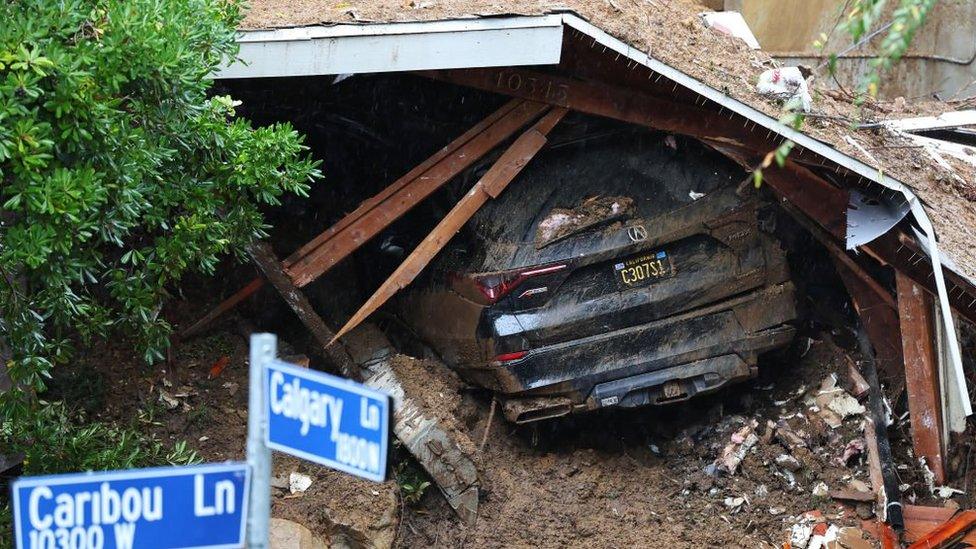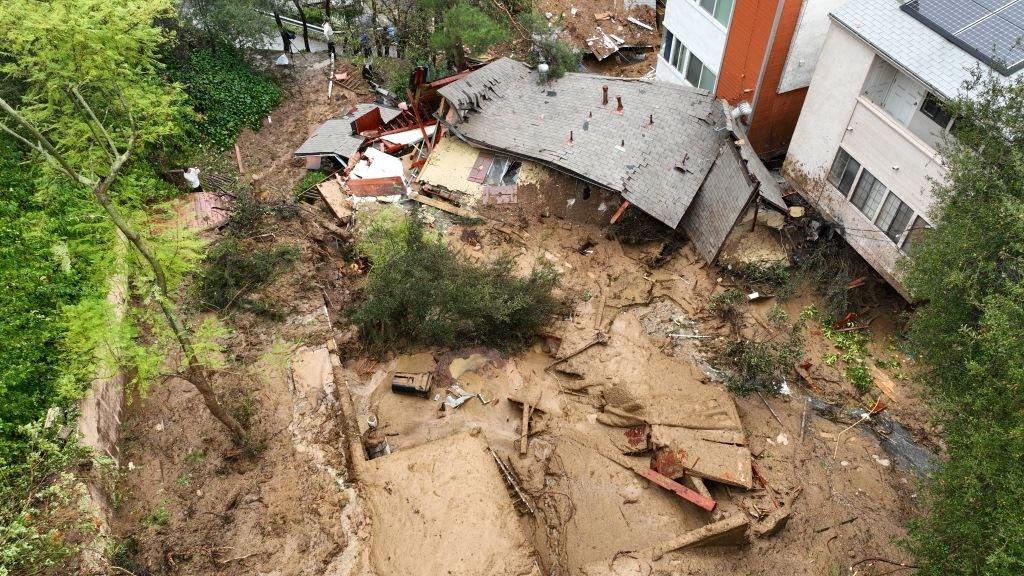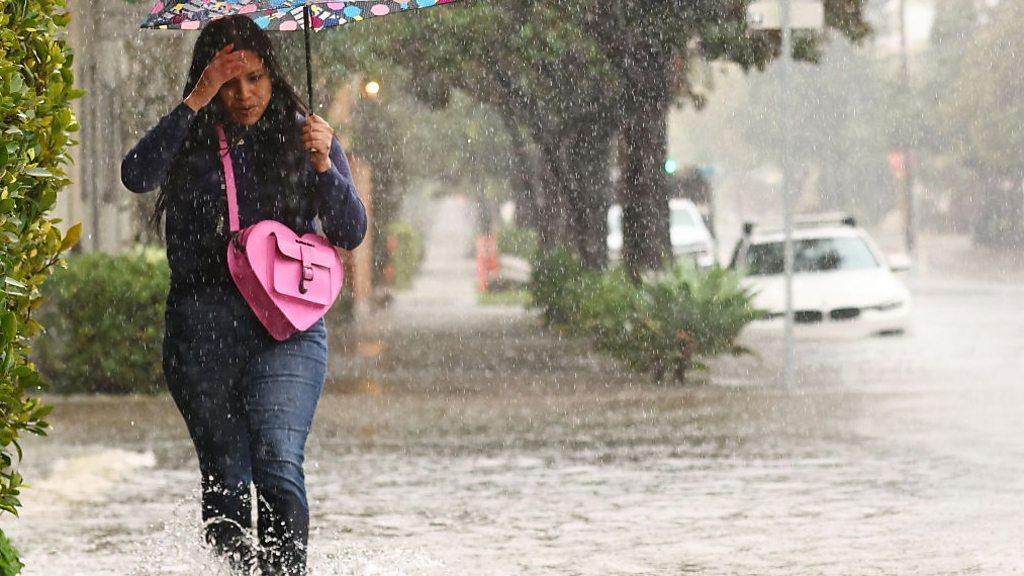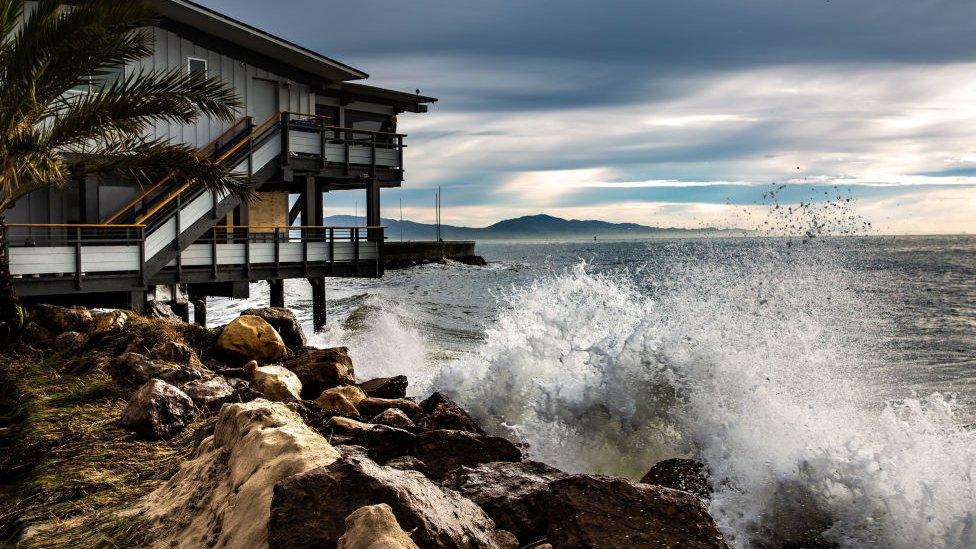California flooding: Storm-soaked neighbourhoods brace for mudslides
- Published
Watch: LA fire department rescue man from surging river
The record rain pounding California since Sunday is expected to linger and drive up the threat of mudslides and flash flooding in urban centres.
The rain was forecast to continue into Tuesday night, placing millions of people under a "high risk" of flooding.
Los Angeles officials have so far tallied 475 landslides and dozens of damaged structures.
Over 104,000 people were without power on Tuesday evening and at least five had been killed by the storm.
In Los Angeles, 4.1in (10.4cm) of rain fell on Sunday in the city's downtown, shattering the previous record set nearly a century ago.
Photos from several of LA's most upmarket neighbourhoods show cars trapped in mud, streets blanketed by water and homes covered in debris.
The city rushed in additional resources on Monday, including search-and-rescue crews and helicopter pilots, adding to the 1,000 firefighters already on duty, the Los Angeles Fire Department said.
"The ground is extremely saturated - supersaturated," said Ariel Cohen, chief National Weather Service (NSW) forecaster in LA.
"It's not able to hold any additional water before sliding. It's not going to take much rain for additional landslides, mudslides, rockslides and other debris flows to occur."
A state of emergency has been declared in eight California counties. On Monday, President Joe Biden called Los Angeles Mayor Karen Bass offering federal assistance to the city.
The LA fire department shared photos, external on Tuesday of a dog that had to be rescued from a river by helicopter.
In the wealthy Beverly Hills neighbourhood, resident Jeb Johenning stood amid cars half buried in muck and debris as he told Reuters "an avalanche of mud" had cascaded down the slope near his home.
"I was driving up here last night, right after the Grammys, and coincidentally, my neighbour, who was in this SUV behind us, was being dropped off at his house, and the driver's coming down the hill, and the mud is chasing the driver," Mr Johenning told the news agency.
The powerful storm is due to an "atmospheric river" effect, a phenomenon in which water evaporates into the air and is carried along by the wind, forming long currents that flow in the sky like rivers flow on land.
This slow-moving storm is the second atmospheric river to hit California in two weeks.
In a Monday briefing, UCLA climate scientist Daniel Swain said the storm had undergone bombogenesis as it approached the state, meaning that colder air mixed with warmer sea air, leading to a swift drop in atmospheric pressure, creating a so-called "bomb cyclone".

A car trapped under a collapsed building on Sunday in Southern California after a powerful storm ripped through the area
The city of San Francisco, one of the hilliest cities in the world, has also been plagued by muddy landslides since the storm's arrival.
Coastal flooding warnings are also in effect as far south as San Diego and the US-Mexico border.
Wind gusts up to 75mph (121 km/h) on Sunday toppled trees and utility lines across the Bay Area and California's Central Coast, stripping power from over 800,000 homes at the storm's peak.
Evacuation orders were in effect for several neighbourhoods around Los Angeles, including in canyon regions where wildfire burn scars mark the landscape.
At least four deaths in northern California have been caused by falling trees.
On Tuesday, the body of a 63-year-old woman was discovered under a tree in the backyard of her home outside Sacramento.
Also on Tuesday, a migrant drowned while attempting to cross the Tijuana River from Mexico, according to US Customs and Border Protection.
Related topics
- Published6 February 2024

- Published5 February 2024

- Published13 March 2023
